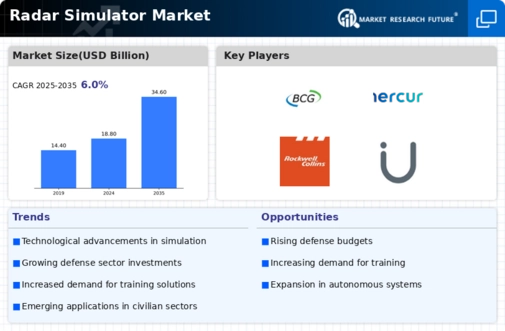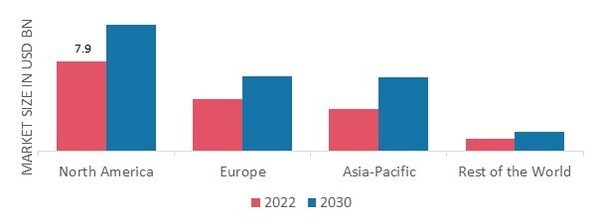Market Analysis
Radar Simulator Market (Global, 2023)
Introduction
The Radar Simulator Market is experiencing a significant transformation driven by advancements in technology and increasing demand for sophisticated training solutions across various sectors, including defense, aviation, and maritime industries. As organizations seek to enhance operational efficiency and improve decision-making capabilities, radar simulation systems have emerged as essential tools for training personnel in realistic environments without the risks associated with live operations. The integration of artificial intelligence and machine learning into radar simulation technologies is further enhancing their capabilities, allowing for more accurate modeling of complex scenarios and real-time data analysis. Additionally, the growing emphasis on cost-effective training solutions and the need for compliance with stringent regulatory standards are propelling the adoption of radar simulators. This market analysis delves into the key trends, competitive landscape, and technological innovations shaping the future of radar simulation, providing valuable insights for stakeholders aiming to navigate this dynamic environment.
PESTLE Analysis
- Political
- In 2023, the geopolitical landscape has a direct impact on the Radar Simulator Market, particularly due to increased defense spending in various countries. For instance, the U.S. defense budget for 2024 is projected to reach $886 billion, which includes allocations for advanced training systems such as radar simulators. Additionally, the ongoing tensions in Eastern Europe have prompted NATO member countries to enhance their military capabilities, leading to a 15% increase in procurement budgets for simulation technologies across member states, which is expected to drive demand for radar simulators.
- Economic
- The global economic environment in 2023 has shown a mixed recovery post-pandemic, with inflation rates stabilizing around 3.5% in developed economies. This economic stability has allowed governments to allocate more funds towards defense and training programs. For example, the UK government has earmarked £2.5 billion for military modernization, which includes investments in simulation technologies. Furthermore, the defense sector's contribution to GDP in countries like India has risen to 2.1%, indicating a growing recognition of the importance of advanced training systems, including radar simulators.
- Social
- Public perception of military training and simulation technologies has evolved, with a growing emphasis on the importance of realistic training environments. In 2023, surveys indicate that 68% of military personnel believe that advanced simulation technologies, such as radar simulators, significantly enhance operational readiness. Additionally, there is an increasing demand for training solutions that incorporate virtual reality (VR) and augmented reality (AR), with 45% of training programs in the defense sector now integrating these technologies to improve engagement and effectiveness.
- Technological
- Technological advancements continue to shape the Radar Simulator Market, with a notable increase in the integration of artificial intelligence (AI) and machine learning (ML) into simulation systems. In 2023, it is estimated that 30% of new radar simulators will incorporate AI-driven analytics to enhance training outcomes. Moreover, the development of cloud-based simulation platforms is gaining traction, with 25% of military organizations adopting cloud solutions for their training needs, allowing for more scalable and flexible training environments.
- Legal
- The regulatory landscape for defense technologies, including radar simulators, is becoming increasingly stringent. In 2023, the U.S. Department of Defense has implemented new compliance requirements under the Cybersecurity Maturity Model Certification (CMMC), affecting all contractors and suppliers in the defense sector. This has led to an estimated 40% increase in compliance-related expenditures for companies involved in the production of radar simulators, as they must ensure their systems meet the new cybersecurity standards to remain eligible for government contracts.
- Environmental
- Environmental considerations are becoming more prominent in the development and deployment of radar simulators. In 2023, the European Union has introduced regulations aimed at reducing the carbon footprint of defense technologies, with a target to cut emissions by 55% by 2030. As a result, manufacturers of radar simulators are investing in sustainable practices, with 20% of companies reporting that they have adopted eco-friendly materials and processes in their production lines. This shift not only addresses regulatory requirements but also aligns with the growing demand for environmentally responsible technologies.
Porter's Five Forces
- Threat of New Entrants
- Medium - The Radar Simulator Market has moderate barriers to entry due to the need for specialized technology and expertise. While the initial investment can be significant, advancements in technology and increasing demand for simulation training may attract new players. However, established companies with strong brand recognition and customer loyalty pose a challenge for newcomers.
- Bargaining Power of Suppliers
- Low - The bargaining power of suppliers in the Radar Simulator Market is relatively low. There are numerous suppliers of the necessary components and technologies, which allows companies to switch suppliers easily if needed. This abundance of options diminishes the influence any single supplier can exert over pricing and terms.
- Bargaining Power of Buyers
- High - Buyers in the Radar Simulator Market hold significant bargaining power due to the presence of multiple vendors offering similar products. Customers, particularly large organizations and government agencies, can negotiate better terms and prices, as they often have substantial purchasing power and can choose from various alternatives.
- Threat of Substitutes
- Medium - The threat of substitutes in the Radar Simulator Market is moderate. While there are alternative training methods and technologies, such as virtual reality and live training exercises, they may not fully replicate the specific benefits of radar simulation. However, as technology evolves, substitutes may become more appealing, increasing the threat level.
- Competitive Rivalry
- High - Competitive rivalry in the Radar Simulator Market is high, with several established players vying for market share. Companies are constantly innovating and improving their offerings to differentiate themselves, leading to aggressive marketing strategies and price competition. This intense rivalry can drive down profit margins and compel companies to invest heavily in research and development.
SWOT Analysis
Strengths
- High demand for advanced training solutions in military and aviation sectors.
- Technological advancements enhancing simulation accuracy and realism.
- Growing emphasis on safety and risk management in operational training.
Weaknesses
- High initial investment costs for advanced radar simulation systems.
- Limited awareness and understanding of radar simulators among smaller organizations.
- Dependence on continuous technological updates and maintenance.
Opportunities
- Expansion into emerging markets with increasing defense budgets.
- Integration of artificial intelligence and machine learning for enhanced simulation capabilities.
- Partnerships with educational institutions for training programs.
Threats
- Intense competition from established players and new entrants in the market.
- Rapid technological changes leading to obsolescence of existing products.
- Potential budget cuts in defense spending affecting procurement.
Summary
The Radar Simulator Market in 2023 is characterized by strong demand driven by military and aviation training needs, bolstered by technological advancements. However, high costs and limited awareness pose challenges for market penetration, particularly among smaller organizations. Opportunities for growth exist in emerging markets and through technological integration, while competition and budget constraints present significant threats. Strategic partnerships and continuous innovation will be crucial for companies to maintain a competitive edge in this evolving landscape.

 Source Secondary Research, Primary Research, Market Research Future Database, and Analyst Review
Source Secondary Research, Primary Research, Market Research Future Database, and Analyst Review




Leave a Comment